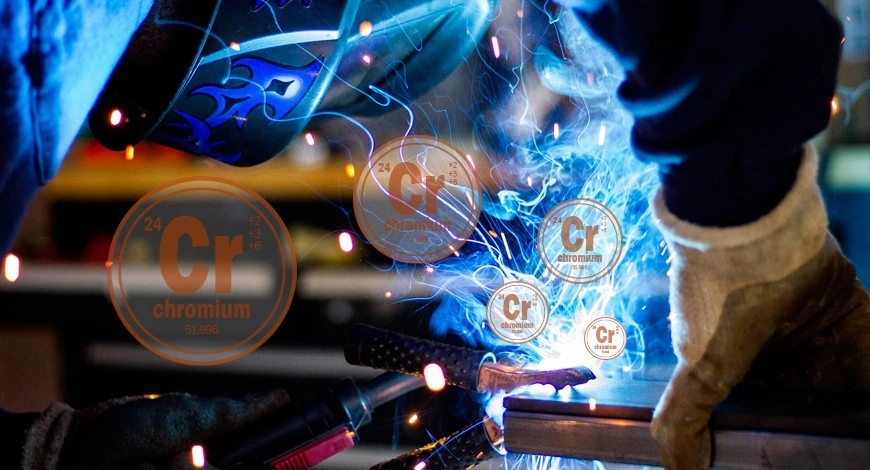
Is Hexavalent Chromium Present In Your Industry?
Do you remember the movie Erin Brockovich? Based on a real-life disaster starring Julia Roberts, the movie shows the ravages of a cancer-causing agent polluting the groundwater of the small town of Hinkley, California. What contaminant caused that tragedy? Hexavalent chromium (or chromium VI).
However, this compound can also be found in the air in many industrial sectors, not just in water and movies! Here is what you need to know about it.
Hexavalent Chromium: The Enemy Of Many Industries
Chromium itself is not dangerous. It is used in a number of alloys to harden certain materials and make them more resistant to corrosion (such as stainless steel, galvanized steel, and carbon steel, with a high carbon content). The problem is that when subjected to high temperatures, it oxidizes and turns into chromium VI, a highly harmful product.
There are many ways it can enter the human body. For example, a worker can breathe in fine hexavalent chromium particles, ingest them by eating or drinking at a contaminated workplace or assimilate it through direct contact with their skin.
There are multiple risks to workers’ health:
- Skin, nose and eye irritation — including an ulcer, eye damage, and perforation of the nasal septum;
- Eardrum perforation;
- Tooth erosion and discolouration;
- Respiratory tract irritation (coughing, breathing difficulties, chronic obstructive pulmonary disease, pulmonary congestion and edema);
- Irritation of the digestive system (stomach ulcers, gastritis, and esophagitis);
- Allergic reaction to chromium (rashes, runny nose, shortness of breath, bronchitis, asthma, pulmonary fibrosis);
- Kidney and liver damage;
- Weakened immune system;
- Lung and bronchus cancer;
- Autoimmune diseases;
- Birth defects.
To know if your employees are at risk, check whether their workplace complies with the Time-weighted average exposure value (TWAEV) for hexavalent chromium, which is 0.05 mg/m3.
Hazardous to Health and the Environment!
Properly filtering and exhausting air containing chromium VI particles is crucial. Otherwise, you run the risk of contaminating the population and areas around your facility — including the air, water, and soil.
In Canada, this is precisely what the Chromium Electroplating, Chromium Anodizing and Reverse Etching Regulations want to ensure by controlling air emissions of hexavalent chromium compounds.
In What Industries Do We Find Chromium VI And Its By-Products?
In the workplace, the most common form of exposure to hexavalent chromium is dust or powder. The most affected sectors need to be extra vigilant: metallurgy (steelworks, iron and steel foundries), wood, aeronautics and textiles, shipyards, transport and construction industries, etc.
Specifically, what industrial processes can expose you to chromium VI?
- Manufacturing of high-temperature-resistant steels;
- Metal finishing (hard chromium plating, electroplating, etc.);
- Paint and pigment applications;
- Steel and alloy welding — and arc welding;
- Cutting, grinding, and sand-blasting processes;
- Thermal spraying;
- Working with or near wet cement and refractory materials such as bricks and mortars;
- Power plant combustion;
- Leather tanning;
- Composition of certain pesticides;
- and much more.
Choose Prevention And Our Solutions — All Complementary!
A tailored dust collection system helps manage contaminants and reduce workers’ exposure to them. Moreover, since hexavalent chromium is odourless, only a measuring instrument can detect it and measure its concentration with the aim of maintaining an adequate threshold value.
Be careful to avoid sweeping and using compressed air jets in the event of an accumulation of chromium VI particles, which would just help spread the contaminant.
In addition to protecting the workers responsible for these processes, don’t forget the cart drivers, maintenance technicians, team leaders, and anyone else who may be in contact with the contaminant!
How to Capture and Filter Hexavalent Chromium in Four Phases:
1. Local exhaust ventilation. Several options are available, including a compact exhaust outlet integrated into a welding process, a downdraft table, an environmental booth, an arm or capture hood above your vats.
2. Personal respiratory protective equipment. Due to the high toxicity of chromium VI, this equipment is required at all times to protect the workers’ breathing zone. If a lot of heat is emitted from the processes, you could also make their work easier for by choosing an air-conditioning system adapted to your environment or a protective device with an air supply.
3. Ventilation and dilution. Combined with the previous two solutions, the fresh air supply helps dilute the concentration of hexavalent chromium in the atmosphere. For example, directing the flow of fresh air toward the welders’ workspace will draw dust and welding fumes down to the floor and protect their breathing zone.
4. Ambient air filtration. An effective dust collection system is required to control and reduce the concentration of chromium VI in the air. Setting up a laminar cross-draft filtration unit with a device like our Power Wall is a good example. Through laminar flow, it creates a horizontal air stream to carry the particles from their point of emission to the suction inlet of its system.
Trust Us For The Best Protection!
First-class solutions are needed to address these important issues. And prevention is just the tip of the iceberg!
As general contractors specializing in ventilation, dust collection, and air management, we can help you find a solution tailored to your facilities. Call us!
